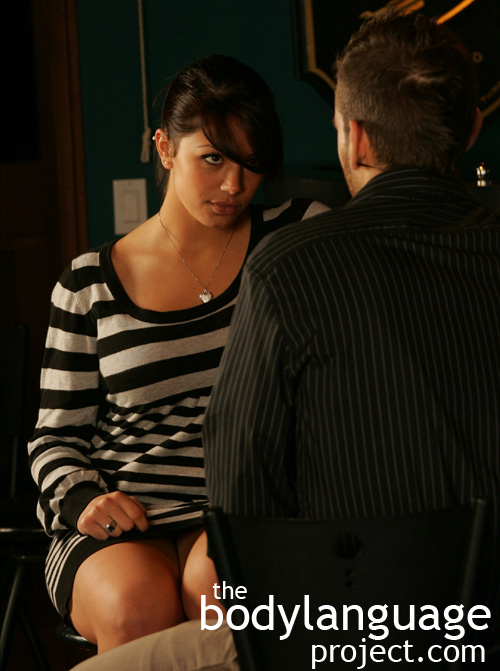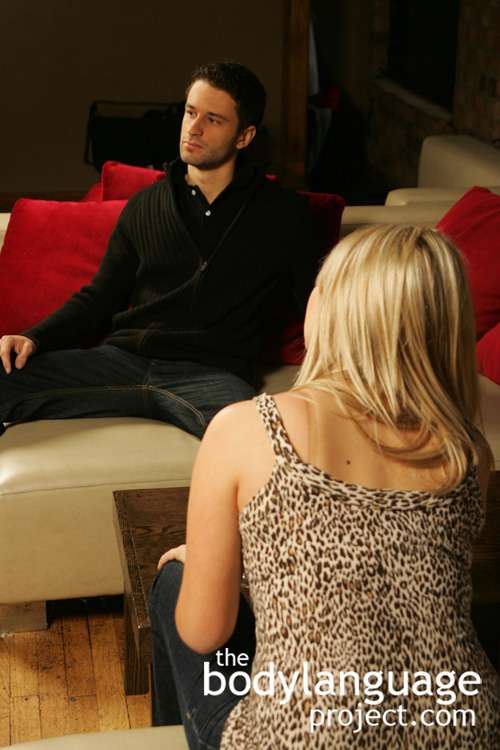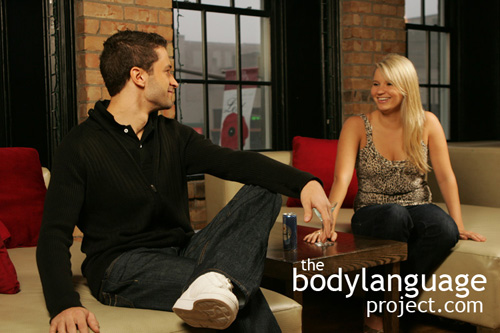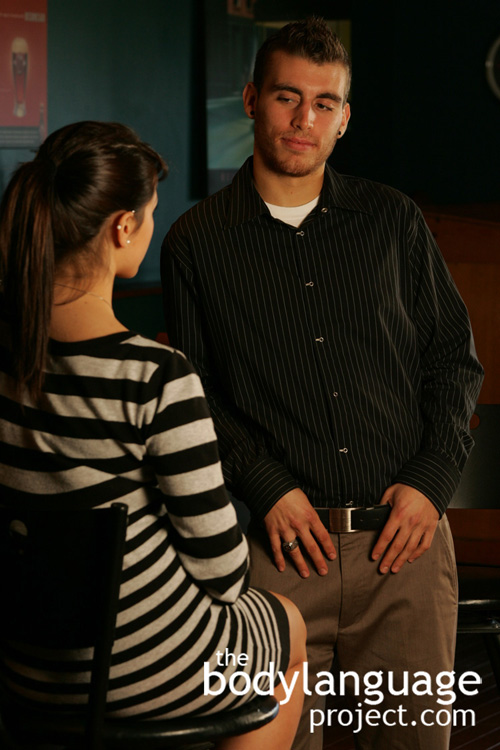Body Language of Uncrossing and Re-Crossing Legs
 Cue: Uncrossing and Re-Crossing Legs.
Cue: Uncrossing and Re-Crossing Legs.
Synonym(s): Re-Crossing The Legs, Thigh Exposure.
Description: When the legs are uncrossed and re-crossed in the presence of men.
In One Sentence: Uncrossing and re-crossing the legs is a female sexual signal aimed to arouse or to make the body more comfortable.
How To Use it: Women can use the cue most effectively. In a dating context, slowly uncrossing then re-crossing the legs whilst making eye contact, is a powerful message few men will mistake for general affect. As the cue is normally used to make the body more comfortable, women may wish to repeat the cue and pause slightly with the legs open. To add even more allure add eye contact with a slight lick of the lips to accompany the movement.
The cue is most sexual with a skirt, particularly a short one. However, it can also work with pants as there is more freedom to sitting with legs open when everything is covered. Teasing can be done when in a private location by exposing the underwear either briefly or fully. If you wish to be sexually obvious, the cue without underwear is your answer.
If women wish to avoid appearing sexual, keep the hand on the lap while re-crossing, avoid eye contact, and do the movement quickly and efficiently without any notable pause.
Context: a) General b) Dating.
Verbal Translation: a) “I’m uncomfortable and need to adjust my sitting position.” b) “I’m sexually available and wish to demonstrate my inner thigh to arouse through a quick flash and tease.”
Variant: See Leg Crossing and Leg Crossing Direction, European Leg Cross, Leg Spreading.
Cue In Action: a) She quickly uncrossed and re-crossed her legs with her hands over her lap. She was trying to maintain her comfort by shifting her body into a new position. b) She made eye contact with an attractive man, dropped her head and lowered her eyes, smirked, uncrossed her legs to reveal the skin of her thigh, wiggled to the music, then re-crossed her legs and took a sip of her drink.
Meaning and/or Motivation: Crossing and uncrossing the legs in the presence of men, especially if done slowly is a demonstration of interest or availability. It becomes particularly salient if the inner thigh is exposed or the legs are momentarily left uncrossed.
Leaving the legs uncrossed altogether, while sitting or standing, or massaging them so as to draw attention to them, can add intensity to the sexual invitation.
Another leg crossing variation happens when the leg is tucked under the body and sat on with the knee pointing toward her interest. This also leaves the inside of the thigh exposed and is particularly alluring when wearing a skirt – especially a short one!
Other times, leg crossing and re-crossing has no meaning at all and simply serves to make the body more comfortable. This is the case when men uncross and re-cross their legs. When done by men, it almost always means that he is shifting to increase his comfort.
Cue Cluster: In order for the cue to have meaning it should be accompanied by other sexual cues such as flirty up-cast eye contact, head lowered, shoulders rounded, wrist exposure and so forth. The more cues in cluster, the more salient the sexual message. When the uncross and re-cross cue is not a sexual message, then eye contact will be avoided, the legs will be held tightly together, the motion will be done subtly so as to avoid detection and hands will be firmly planted over the mid-section to hide the skin from view.
Body Language Category: Adaptors, Amplifier, Courtship display, Indicators of sexual interest (IOsI).
Resources:
Allen, Terre H. ; Honeycutt, James M. Planning, Imagined Interaction, and the Nonverbal Display of Anxiety. Communication Research. 1997. 24(1): 64-82.
Abbey, A., and Melby, C. (1986). The effects of nonverbal cues on gender differences in perceptions of sexual intent. Sex Roles, 15, 283-298.
Abrahams, Matthewf. Perceiving flirtatious communication: An exploration of the perceptual dimensions underlying judgments of flirtatiousness. Journal of Sex Research. 1994. 31(4): 283-292.
Burgoon, Judee ; Poire, Beth ; Beutler, Larry ; Bergan, John ; Engle, David. Nonverbal behaviors as indices of arousal: Extension to the psychotherapy context. Journal of Nonverbal Behavior. 1992. 16(3): 159-178.
Cari D. Goetz; Judith A. Easton; David M.G. Lewis; David M. Buss. Sexual Exploitability: Observable Cues And Their Link To Sexual Attraction. Evolution and Human Behavior. 2012; 33: 417-426.
http://bodylanguageproject.com/articles/victim-blaming-or-useful-information-in-preventing-rape-and-sexual-exploitation/
Cantú, Stephanie M ; Simpson, Jeffry A ; Griskevicius, Vladas ; Weisberg, Yanna J ; Durante, Kristina M ; Beal, Daniel J. Fertile and Selectively Flirty. Psychological Science. 2014. 25(2): 431-438.
Clark, A. Attracting Interest: Dynamic Displays of Proceptivity Increase the Attractiveness of Men and Women. Evolutionary Psychology. 2008., 6(4), 563-574.
http://bodylanguageproject.com/articles/risky-versus-proceptive-nonverbal-sexual-cues/
Durante, Kristina M ; Li, Norman P ; Haselton, Martie G. Changes in women’s choice of dress across the ovulatory cycle: naturalistic and laboratory task-based evidence. Personality & social psychology bulletin. 2008 34(11): 1451-60.
Dreznick, Michaelt. ; Cronin, Josephm. ; Waterman, Carolinek. ; Glasheen, Cristie. Saying Yes when Meaning No: An Investigation of Gender and Individual Differences in Token Seduction. Journal of Psychology & Human Sexuality. 2003. 15(1): 69-84.
de Bruijn G. From masturbation to orgasm with a partner: how some women bridge the gap–and why others don’t. J Sex Marital Ther. 1982. 8(2):151-67.
Cameron C., S. Oskamp and W. Sparks. 1978. Courtship American style: newspaper
advertisements. Family Coordinator 26: 27-30.
Clark, A. Attracting Interest: Dynamic Displays of Proceptivity Increase the Attractiveness of Men and Women. Evolutionary Psychology. 2008., 6(4), 563-574. http://bodylanguageproject.com/articles/risky-versus-proceptive-nonverbal-sexual-cues/
Clifford, Ruth. Development of masturbation in college women. Archives of Sexual Behavior. 1978. 7(6): 559-573.
Dosmukhambetova, D., and Manstead, A. Strategic Reactions to Unfaithfulness: Female Self-Presentation in the Context of Mate Attraction is Link to Uncertainty of Paternity. Evolution and Human Behavior. 2011. 32, 106-107.
de Lemus, Soledad; Russell Spears and and Miguel Moya. The Power of a Smile to Move You: Complementary Submissiveness in Women’s Posture as a Function of Gender Salience and Facial Expression. Personality and Social Psychology Bulletin. 2012. 38(11): 1480-1494.
Fujiwara, Ken ; Daibo, Ikuo. The Extraction of Nonverbal Behaviors: Using Video Images and Speech-Signal Analysis in Dyadic Conversation. Journal of Nonverbal Behavior. 2014. 38(3): 377-388.
Festjens, Anouk; Sabrina Bruyneel and Siegfried Dewitte. What a Feeling! Touching Sexually Laden Stimuli Makes Women Seek Rewards. Journal of Consumer Psychology. 2013. http://dx.doi.org/10.1016/j.jcps.2013.10.001
http://bodylanguageproject.com/articles/not-sexy-images-sexy-touch-drives-womens-purchases/
Farley, James; Risko, Evan F; Kingstone, Alan. Everyday Attention And Lecture Retention: The Effects Of Time, Fidgeting, And Mind Wandering. Frontiers In Psychology, 2013; 4: 619
http://bodylanguageproject.com/articles/mind-wandering-fidgeting-and-attention/
Givens D. The nonverbal basis of attraction: Flirtation, courtship, and seduction. Psychiatry. 1978. 41: 346.
Grammer, Karl ; Kruck, Kirsten ; Juette, Astrid ; Fink, Bernhard. Non-verbal behavior as courtship signals: the role of control and choice in selecting partners. Evolution and
Human Behavior. 2000. 21(6): 371-390.
Greer, Arlettee. ; Buss, Davidm. Tactics for promoting sexual encounters. Journal of Sex Research. 1994. 31(3): 185-201.
Goetz, Cari D.; Judith A. Easton; David M.G. Lewis; David M. Buss. Sexual Exploitability: Observable Cues And Their Link To Sexual Attraction. Evolution and Human Behavior. 2012; 33: 417-426.
http://bodylanguageproject.com/articles/victim-blaming-or-useful-information-in-preventing-rape-and-sexual-exploitation/
Goetz, Cari D.; Judith A. Easton; Cindy M. Meston. The Allure of Vulnerability: Advertising Cues to Exploitability as a Signal of Sexual Accessibility. Personality and Individual Differences. 2013. 62: 121-125. http://dx.doi.org/10.1016/j.paid.2014.02.019
http://bodylanguageproject.com/articles/allure-sexual-vulnerability-move/
Guéguen Nicolas. Gait and menstrual cycle: ovulating women use sexier gaits and walk slowly ahead of men. Gait Posture. 2012; 35(4): 621-4.
http://bodylanguageproject.com/articles/gait-as-bait-women-walk-sexy-during-high-sexual-receptivity/
Guéguen, Nicholas. High Heels Increase Women’s Attractiveness. Archives of Sexual Behavior. 2014. DOI 10.1007/s10508-014-0422-z
http://bodylanguageproject.com/articles/high-heels-exact-power-men-study-women-wear-heels/
Guéguen, Nicolas. The Effect Of Women’s Suggestive Clothing On Men’s Behavior And Judgment: A Field Study. Psychological Reports. 2011. 109; 2: 635-638.
http://bodylanguageproject.com/articles/sexy-clothing-source-power-women/
Grammer, Karl, LeeAnn Renninger and Bettina Fischer. Disco Clothing, Female Sexual Motivation, and Relationship Status: Is She Dressed to Impress? The Journal of Sex Research. 2004. 41(1): 66-74.
http://bodylanguageproject.com/articles/is-she-dressed-for-success-how-women-adorn-during-courtship/
Hill, Clara E. ; Stephany, Alicia Harmon, Lenore W. (editor). Relation of Nonverbal Behavior to Client Reactions. Journal of Counseling Psychology. 1990. 37(1): 22-26.
Hartfeil E. and S. Sprechler. 1986. Mirror, Mirror…The Importance of Looks in Everyday Life. State University of New York Press, Albany.
Hald, G. M., & Høgh-Olesen, H. Receptivity to Sexual Invitations from Strangers of the Opposite Gender. Evolution and Human Behavior. 2010. 31, 453-458.
Hall, Jeffrey A. and Chong Xing. The Verbal and Nonverbal Correlates of the Five Flirting Styles. Journal of Nonverbal Behavior. 2015. 39(1): 41-68. http://bodylanguageproject.com/articles/flirt-science-flirting-style-linked-nonverbal-verbal-behavior/
Legrand, Lore B; Marzia Del Zotto; Remi Tyrand and Alan J. Pegna. Basic Instinct Undressed: Early Spatiotemporal Processing for Primary Sexual Characteristics. PLOS one. 2013. 8(7): e69726. doi:10.1371/journal.pone.0069726
http://bodylanguageproject.com/articles/naked-body-rivals-naked-face-study-looks-brain-responds-nude-bodies/
Lynch, A. Expanding the Definition of Provocative Dress: An Examination of Female Flashing Behavior on a College Campus. Clothing and Textiles Research Journal. 2007. 25(2): 184-201.
Michael Reiβ. Leg-crossing: Incidence and inheritance. Neuropsychologia. 1994. 32(6): 747-750.
Moore, Monicam. Human Nonverbal Courtship Behavior—A Brief Historical Review. Journal of Sex Research. 2010 47(2-3): 171-180.
Moore, Monica. Courtship Signaling and Adolescents: Girls Just Wanna Have Fun. Journal of Sex Research. 1995. 32(4): 319-328.
http://bodylanguageproject.com/articles/girls-just-want-to-have-fun-the-origins-of-courtship-cues-in-girls-and-women/
Moore, Monica. M. Nonverbal Courtship Patterns in Women: Context and consequences. Ethology and Sociobiology. 1985. 6:237- 247.
Moore, M. M. Courtship Communication and Perception. Perceptual and Motor Skills. 2002. 94(1): 97-105. doi:10.2466/PMS.94.1.97-105.
Moore, M. M. and D. L. Butler. 1989. Predictive aspects of nonverbal courtship behavior in women. Semiotica 76(3/4): 205-215.
Moore, M. M. 2001. Flirting. In C. G. Waugh (Ed.) Let’s talk: A cognitive skills approach to interpersonal communication. Newark, Kendall-Hunt.
McCormick, Naomi B. and Andrew J. Jones. Gender Differences in Nonverbal Flirtation. Journal of Sex Education and Therapy. 1989. 15(4): 271-282.
O’Sullivan, Luciaf. ; Byers, E. Sandra. Eroding stereotypes: College women’s attempts to influence reluctant male sexual partners. Journal of Sex Research. 1993 30(3): 270-282.
Perper, T., and Weis, D. L. (1987). Proceptive and rejective strategies of U. S. and Canadian college women. The Journal of Sex Research, 23, 455-480.
Petrican, Raluca; Christopher T. Burris and Morris Moscovitch. Shame, Sexual Compulsivity, and Eroticizing Flirtatious Others: An Experimental Study. Journal of Sex Research. 2015. 52(1), 98–109, 2015. DOI: 10.1080/00224499.2013.829796
http://bodylanguageproject.com/articles/coy-flirtatious-smile-eye-contact-leads-shame-sex/
Pinar, Rukiye ; Ataalkin, Sıddıka ; Watson, Roger. The effect of crossing legs on blood pressure in hypertensive patients. Journal of Clinical Nursing. 2010. 19(9-10): 1284-1288.
Park, Yongnam ; Bae, Youngsook. Comparison of Postures According to Sitting Time with the Leg Crossed. Journal of Physical Therapy Science. 2014. 26(11): 1749-1752.
Peters. M. Footedness: asymmetries in foot preference and skill and neuropsychological assessment of foot movement. Psycho/. Bull. 103, 179 192, 1988.
Plato. C. C., Fox, K. M. and Gakruto, R. M. Measures of lateral functional dominance: Foot preference. digital interlocking, arm-folding and fool overlapping. Human Biology. 1985. 57: 327-334.
Reiss M. Leg-crossing: incidence and inheritance. Neuropsychologia. 1994. 32(6):747-50.
Roberts, Tomi-Ann and Yousef Arefi-Afshar. Not All Who Stand Tall Are Proud: Gender Differences in the Proprioceptive Effects of Upright Posture. Cognition and Emtion. 2007. 21(4):714-727.
http://bodylanguageproject.com/articles/do-women-benefit-from-power-posing-study-suggests-not/
Sturman, Edward D. Invluntary Subordination and Its Relation to Personality, Mood,
and Submissive Behavior. Psychological Assessment. 2011. 23(1): 262-276 DOI: 10.1037/a0021499
http://bodylanguageproject.com/articles/nonverbal-submission-men-women-depression-critical-examination-use-disuse-submission/
Stanton, Steven J. and Robin S. Edelstein. The Physiology of Women’s Power Motive: Implicit Power Motivation is Positively Associated With Estradiol Levels in Women. Journal of Research in Personality. 2009. 43: 1109-1113.
http://bodylanguageproject.com/articles/the-estrogen-factor-the-search-for-nonverbal-power-in-women/
Stanton, Steven J. The Essential Implications of Gender in Human Behavioral Endocrinology Studies. Frontiers in Behavioral Neuroscience. 2011. 5(9): 1-3. doi: 10.3389/fnbeh.2011.00009
http://bodylanguageproject.com/articles/a-critical-commentary-on-amy-cuddys-power-posing/
Sherwin, Miranda. Deconstructing the male gaze: masochism, female spectatorship, and the femme fatale in Fatal Attraction, Body of Evidence, and Basic Instinct.(Critical essay). Journal of Popular Film and Television. 2008. 35(4): 174(9).
Shotland, L. R., & Craig, J. M. (1988). Can men and women differentiate between friendly and sexually interested behavior? Social Psychology Quarterly, 51, 66-73.
Seli, Paul; Jonathan S. A. Carriere; David R. Thomson; James Allan Cheyne, Kaylena A. Ehgoetz Martens, and Daniel Smilek. Restless Mind, Restless Body Journal of Experimental Psychology: Learning, Memory, and Cognition. American Psychological Association. 2014. 40(3): 660-668. 0278-7393/14/$12.00 DOI: 10.1037/a0035260
http://bodylanguageproject.com/articles/fidgeting-body-language-really-mean-fidget-bored-mentally-taxed/
Tiedens, Larissa Z. and Alison R. Fragale. Power Moves: Complementarity in Dominant and Submissive Nonverbal Behavior. Journal of Personality and Social Psychology. 2003, 84(3): 558–568.
Van Velthoven, Michelle H M M T ; Thien, Theo ; Holewijn, Suzanne ; Van Der Wilt, Gert Jan ; Deinum, Jaap. The effect of crossing legs on blood pressure. Journal of hypertension. 2010. 28(7): 1591-2.
Walsh, D. G., & Hewitt, J. (1985). Giving Men The Come-On: Effect Of Eye Contact And Smiling In A Bar Environment. Perceptual and Motor Skills, 61, 873-874.
Weerth, Carolina ; Kalma, Akko. Gender differences in awareness of courtship initiation tactics. Sex Roles. 1995. 32(11): 717-734.








